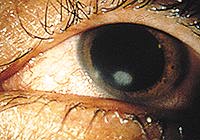Infections - Cornea & Conjunctiva
Conjunctiva
- What is conjunctivitis?
- Commonly known as Pink Eye, conjunctivitis is an infection of the conjunctiva (the inside of the eyelid). It can be caused by bacteria, virus or allergies (see the Allergy section)
- Signs and symptoms:
- Red, irritated, watery eyes with a burning and scratchy feeling. May have pus or watery discharge.
- Preventing the spread of the infection:
- Pink Eye spreads very easily. Wash hands before and after using the medicine in your eye. Wash any clothes, towels, pillow cases touched by the infected eye. Avoid sharing cosmetics.
- Treatment:
- See your eye care specialist.
- Usually an antibiotic will be selected by your eye care specialist
Corneal Foreign Body
Bacterial Keratitis (Corneal Ulcer)
- What is bacterial Keratitis (Corneal ulcer)?
- A corneal ulcer is an infection of the cornea by bacteria, viruses or fungi. Two of the common causes are: Abrasion of the cornea with foreign bodies and poor hygiene of contact lenses (especially if worn overnight).
- Signs and symptoms
- Eye pain, redness, itching and burning, white patch on the cornea, increased tearing, sensitivity to light (photophobia).
- Preventing the spread of the infection
- Early attention by an ophthalmologist or optometrist to any eye infection could prevent the ulceration and further injury to the cornea. An untreated corneal ulcer can permanently damage the cornea. It could also perforate the eye, resulting in a spread of infection, increasing the risk of permanent visual impairment.
- Treatment
- See your eye care specialist.
- Usually an antibiotic will be selected by your eye care specialist
Chlamydial & Gonococcal Conjunctivitis
.jpg)
.jpg)
What is Chlamydial conjunctivitis?
-
- An infection of the inner lid which typically affects sexually active teens and young adults. Chlamydia is considered one of the major sexually transmitted pathogens. Women seem to be more susceptible than men. This infection also affects infants whose mothers have untreated chlamydial conjunctivitis The incidence of infection seems to be directly related to sexual activity.
- Sign and symptoms
- Persistent eye infection (3 weeks or more) with common mucus discharge.
- Systemically, signs and symptoms could include a history of vaginitis, pelvic inflammatory disease or urethritis.
- Ocular signs and symptoms include the chief complaint that an eye infection has persisted for over three weeks despite treatment with topical antibiotics. Mucus discharge is common.
- What is Gonococcal conjunctivitis?
- Also a sexually transmitted ocular disease. Even casual interaction with infected individuals has been reported as a cause. Newborn infants could acquire the infection by passing through an infected birth canal. This is a very contagious ocular disease.
- Signs and symptoms
- Red eye with foreign body sensation. The eye could be shut with substantial pus discharge. The incubation period is generally two to seven days.
- Preventing the spread of the infection
- The transmission to the eye can lead to from hand contact from a site of genital infection to the eye. Infected pregnant mothers can infect the newborn. Avoid sharing cosmetics.
- Treatment
- See your eye care specialist
- Usually an antibiotic will be selected by your eye care specialist.
.jpg)
.jpg)

.jpg)
.jpg)